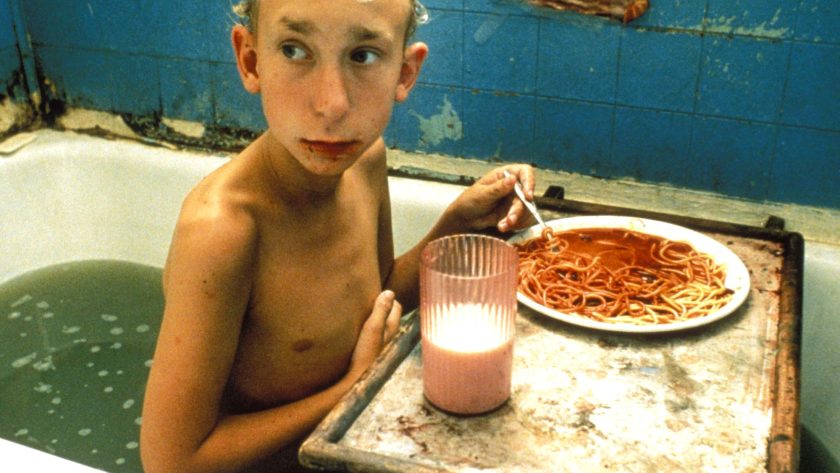Anya Somwaiya reviews Korine’s debut feature, Gummo, a mood board for the decades that followed.
Scotch taped wall bacon. Albinos and drunkards. Girls with no
eyebrows and titty lumps. Cat killing tween hooligans nourished
solely on a diet of spaghetti and frozen pizza. Obsessive
vignettes of middle American nihilism, or life as it is. Clean
of the obfuscation through plotlines and didactic meanings,
‘Gummo’ is the hand-held camera that hovers in closer. The fly
feeding off the layer of grime blanketing Korine’s offbeat and
strange world.
In his 1998 interview with Frieze’s Bruce Hainley, Korine named
the subversions and contradictions of middle America “pop
schizophrenia”: its backwardness with race and economy lain
beside its edginess i.e., its birthing of the mullets and rat
tails we see so often on rugby shirted private school boys. The
film’s treatment of this pop schizophrenia is neither of
critique or lauding, but a curious intimacy and compassion.
The film doesn’t comment overtly on the left-behind state of
middle America. It doesn’t treat the tornado or any other
happening as an inciting event, device, or metaphor, but rather
opens windows into the malaise and bizarro scenes of an unseen
peoples. As if sharing in a life you’ve never known and seeing
things you’ve never seen (one of Korine’s central fixations) is
itself an outcome. Their saturated, irresolute, and breathing
pictures squirming their way under your skin, boring into your
skull to live on forever inside you. Their capture on film being
an act of love.
The mangled town of Xenia is reminiscent of Faulkner’s
Yoknapatawpha, the eeriness of its people remindful of the
taboo-filled Southern Gothics. From mangled animals to humanoid
deformity; religion, incest, and death. Gummo is not a period
piece. It is not neo-gothic or neo-anything. With its
anachronisms of new (at the time) heavy metal and old timey,
Buddy Holly croons, its scenes appropriate liminal spaces that
draw attention to the bones of humanity. Boy in bunny hat pisses
from overpass. Tap dancing mother picks up gun, plays Madonna.
Madonna being of a certain epoch, sure, but in Gummo her synths
and singing may as well be from planet xenon.
Gummo’s has guarded its place in the cultural canon, with
Chloe Sevigny’s ‘Dot’ foreshadowing fits sported by models in I-D these days – that being said, the satanic German convict screamo / Norwegian black metal still hasn’t exactly
broken mainstream. Stills of the debut feature are found so readily on Pinterest alongside the photography of Davide Sorrenti and grainy iPhone uploads from kids in the very suburbia it captured 30 years ago. Its beauty is not lost in the modern reimagining of its consumption, because all Gummo ever was was a flipbook. A ruminant flipbook made of compassion
and obsession, made only to showcase the strange beauty of humanity, sometimes only faintly humanoid.
“Life is beautiful, really it is. Without it you’d be dead.”
~ Gummo




